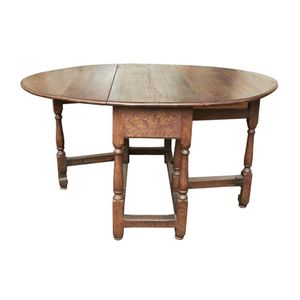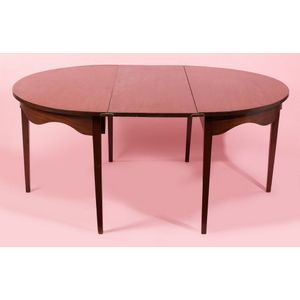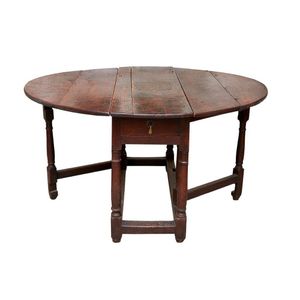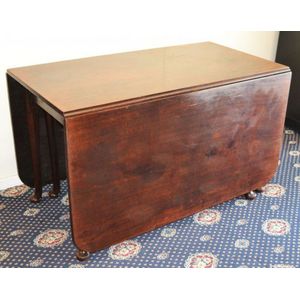
17th/18th Century English Oak Gateleg Table
An English oak gateleg table, late 17th/early 18th century, the oval flap top on slender baluster turned supports united by stretchers, height 78 cm, width 135 cm (extended), depth 117 cm. Provenance: Joan and Charles Mortimer, 'The Sugar House', great…

Lime-Washed Oak Gateleg Table: Compact and Stylish
A lime-washed oak gateleg table, 74 cm high, 122 cm wide (unfolded), 94 cm deep

19th Century Georgian Oak Gate-Leg Table
Georgian oak gate-leg table late 19th century the oval top above turned and squared section gate legs, height 67 cm, width 129 cm, depth 105 cm. Provenance: Private Collection, Sydney.

Oval Oak Gate-Leg Table from Andrew Pratten Estate
Oak gate-leg table, the oval top above turned and squared section gate legs, height 73 cm, width 154 cm, depth 90 cm. Provenance: The Estate of Andrew Pratten, Sydney

Heppelwhite Extension Dining Table with Demilune Console Aprons
A Heppelwhite mahogany extension dining table circa 1780, the 'D' ends with apron fronts functioning alternatively as demilune consoles, the central gate leg component has a drop-leaf, and a spare leaf, the whole raised on square tapered legs 72 cm high,…

18th Century Oak Gate-Leg Table
George III oak gate-leg table 18th century, with square edge twin-flap oval top, above bobbin turned and square legs joined by stretchers, height 71 cm width 126 cm depth 107 cm. Provenance: The Collection of Mr and Mrs Matthew Handbury, Sydney

Cedar Games Table with Fold-Over Top and Drawers
Colonial cedar games table with fold over top supported by a rear gate leg above 2 drawers to the front, 109 cm x 109 cm, open, 75 cm high

Victorian Cedar Gate Leg Table with Drawer
A Victorian cedar dropside gate leg table, with one drawer 71 x 93 x 81 cm, (opened)

George II Mahogany Gate Leg Dining Table, 18th Century
A George II mahogany gate leg dining table, mid 18th century Extends to seat 8 dining chairs height 71 cm, top: 122 x 60.5 cm, Extended: 122 x 186 cm Provenance: Sotheby's 1994 Lot: 11 - Ex Dr. Clifford Craig collection Launceston, Tasmania, to Prominent…

Cedar Foldover Tea Table, Australian, circa 1840
A cedar gate-leg foldover tea table, Australian, circa 1840, 74 cm high, 98.5 cm wide, 45.5 cm deep

English Oak Gate Leg Table, 1690
A small oak gate leg table, English, circa 1690. 65 cm high, 80 cm diameter. Provenance: Westbury Antiques, Melbourne
 Loading more...
Loading more...